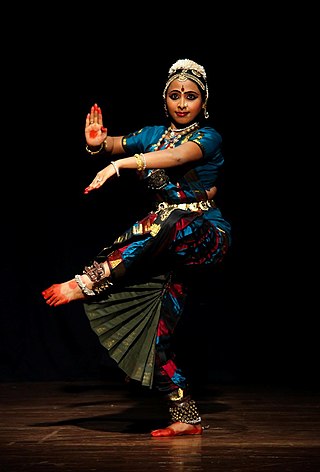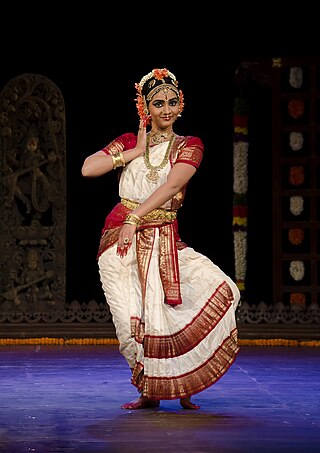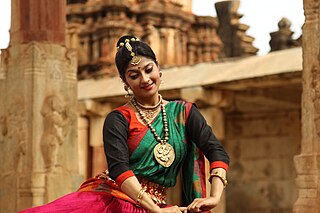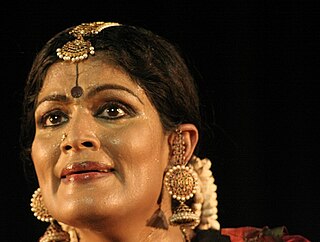
Bharatanatyam is an Indian classical dance form that originated in Tamil Nadu, India. It is a classical dance form recognized by the Sangeet Natak Akademi, and expresses South Indian religious themes and spiritual ideas of Hinduism and Jainism.

Kuchipudi is one of the eight major Indian classical dances. It originates from a village named Kuchipudi in the Indian state of Andhra Pradesh. Kuchipudi is a dance-drama performance, with its roots in the ancient Hindu Sanskrit text of Natya Shastra. It developed as a religious art linked to traveling bards, temples and spiritual beliefs, like all major classical dances of India.

Indian classical dance, or Shastriya Nritya, is an umbrella term for different regionally-specific Indian classical dance traditions, rooted in predominantly Hindu musical theatre performance, the theory and practice of which can be traced to the Sanskrit text Natya Shastra. The number of Indian classical dance styles ranges from six to eight to twelve, or more, depending on the source and scholar; the main organisation for Indian arts preservation, the Sangeet Natak Academy recognizes eight: Bharatanatyam, Kathak, Kuchipudi, Odissi, Kathakali, Sattriya, Manipuri and Mohiniyattam. Additionally, the Indian Ministry of Culture includes Chhau in its list, recognising nine total styles. Scholars such as Drid Williams add Chhau, Yakshagana and Bhagavata Mela to the list. Each dance tradition originates and comes from a different state and/or region of India; for example, Bharatanatyam is from Tamil Nadu in the south of India, Odissi is from the east coast state of Odisha, and Manipuri is from the northeastern state of Manipur. The music associated with these different dance performances consists many compositions in Hindi, Malayalam, Meitei (Manipuri), Sanskrit, Tamil, Odia, Telugu, Assamese, and many other Indian-Subcontinent languages; they represent a unity of core ideas and a diversity of styles, costumes, and expression.

Mungara Yamini Krishnamurthy was an Indian classical dancer recognized for her contributions to Bharatanatyam and Kuchipudi. She was a recipient of the Padma Shri (1968), Padma Bhushan (2001), Padma Vibhushan (2016) and Sangeet Natak Akademi Award (1977).

Kanak Rele was an Indian dancer, choreographer, and academic best known as an exponent of Mohiniyattam. She was the founder-director of the Nalanda Dance Research Centre and the founder-principal of the Nalanda Nritya Kala Mahavidyalaya in Mumbai.

Sunanda Nair is an Indian dancer trained in Mohiniattam. She did her master's degree in this dance form from Nalanda Nritya Kala Mahavidyalaya affiliated to the University of Mumbai. She has completed her PhD from University of Mumbai for her thesis "Intrinsic Lyrical Feminism in Mohiniattam". She was born in Mumbai, India.

"Bombay" Jayashri Ramnath is an Indian Carnatic vocalist, singer, and musician. She has sung songs in multiple languages, including for Tamil, Telugu, Kannada, Malayalam, and Hindi movies. Born into a family of musicians, Jayashri represents the fourth generation of music practitioners in her family. Trained by Lalgudi Jayaraman and T.R. Balamani. She was awarded India's fourth highest civilian award, the Padma Shri, in 2021. In December 2023, she was awarded the most prestigious award in the Carnatic music field, the Sangeetha Kalanidhi, by the Madras Music Academy. She was nominated for an Academy Award for Best Original Song (Oscar) for Pi's Lullaby from Life of Pi movie. She has become one of the most sought-after Carnatic musicians today.

Chitra Visweswaran is an Indian Bharata Natyam dancer who runs a dance school, the Chidambaram Academy of Performing Arts, in Chennai.

Anita Ratnam is an Indian classical and contemporary dancer and choreographer. Classically trained in Bharat Natyam, she has also received formal training in Kathakali, Mohiniattam, and tai chi and Kalarippayattu, thus creating a dance style which she has coined "Neo Bharatam".
Alarmel Valli is an Indian classical dancer and Bharatanatyam-Pandanallur choreographer.
Smitha Madhav is a Carnatic Classical Singer and Bharatanatyam Dancer. Carnatic music is a system of music commonly associated with the southern part of India and one of the two main classifications of Indian Classical Music.

K. Venkatalakshamma was a renowned Bharatanatyam dancer. A doyenne of the Mysore Style of Bharatanatyam, she was the last representative of the Mysore court tradition. She was awarded the Padma Bhushan, India's third highest civilian honour, in 1992.

Nirupama Rajendra is an Indian classical dancer in the Bharathnatyam and Kathak dance forms. She is based in Bangalore, Karnataka. Nirupama and her husband Rajendra perform Kathak together. They established the Abhinava Dance Company in 1994 with an aim to make dance more accessible. They are known for fusing traditional and contemporary dance styles. The dance duo has given many performances and received several awards including Natya Mayuri and Natya Mayura (1998), Karnataka Kalashree (2011) and Nritya Choodamani.

Murugashankari Leo is an Indian dance tutor, theatric actor, and research scholar.

Geeta Chandran is an Indian Bharatanatyam dancer and vocalist. Trained in Carnatic music, she is a visionary and celebrated artist in Indian classical Bharatanatyam, recognized for her work in theatre, dance, education, videos and films.

Ananda Shankar Jayant is an Indian classical dancer, choreographer, scholar and bureaucrat, known for her proficiency in the classical dance forms of Bharatanatyam and Kuchipudi. She is the first woman officer in the Indian Railway Traffic Service on South Central Railway and her 2009 TED talk is ranked among the top twelve Incredible TED talks on cancer. She is a recipient of Sangeet Natak Akademi Award, Kalaimamani Award of the Government of Tamil Nadu and Kala Ratna Award of the Government of Andhra Pradesh. The Government of India awarded her the fourth highest civilian honour of the Padma Shri, in 2007, for her contributions to arts.
Meenakshi Srinivasan is an Indian classical dancer and choreographer, and an exponent of the Pandanallur style of Bharatnatyam. She trained under Alarmel Valli and is considered among the most promising soloists of the younger generation of dancers in this traditional style.

Puru Dadheech is a Kathak dancer. He is a choreographer and educator of Indian classical dance, and is known for his pioneering work in the field of Kathak. At the oldest Kathak department which was formed in 1956 at Indira Kala Sangeet Vishwavidyalaya Public University located in Khairagarh, Puru Dadheech instated the first Kathak syllabus in 1961. He is the holder of the first Doctorate in Kathak Classical Dance and emphasizes the relevance of Shastras in the Kathak repertoire. He was awarded Padma Shri, the 4th highest civilian award of India He is currently serving as the Director of the world's first dedicated Kathak research Centre at the Sri Sri University, Cuttack called Sri Sri Centre for Advanced Research in Kathak.

Mithun Shyam is an Indian Bharatanatyam dancer, choreographer and teacher based in Bengaluru. He has contributed to social and gender-based themes through classical dance.
S. Narmada popularly known as Guru Narmada was a Bharatanatyam exponent and teacher from Karnataka, India. She received several awards including Sangeet Natak Akademi Award, Karnataka Sangeeta Nritya Academy Award, Rajyotsava Prashasti and Shantala Natya Sri Award.















